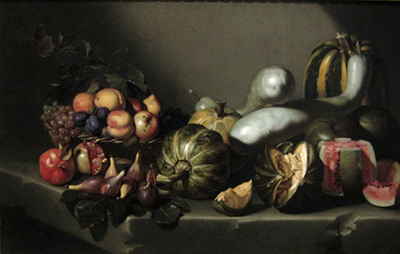Grand and Beautiful
What is set and looks like a forthright display of fruit, raises beyond that blunt definition, into a compositional, highly thought and studied masterpiece, complex and meticulously designed, every thought and brush giving birth to grand utopia best described as just ‘the hearts appeal’.
Caravaggio’s work, skilfully, and dramatically exemplifies the very advance made in the genre of still-life painting. ‘Still Life with Fruit on a Stone Ledge’ is the evocative and monumental illustration of the First Generation of Roman Still life painting.
From the far left side of the painting, attention is called to the seemingly simple basket, filled with grapes, pear, figs and apples. Such alluring representations of fruits in a basket has roots that go as far back as the famous Roman Wall Paintings that are very much common in ancient villas, depicted in both mosaic and painting form.
The composition well-designed here carefully draws viewer’s eye from left to right. Straight from the basket of fruit, leading across to the well-placed group of eight figs, as well as, the three round striped melons. Not only that, but we also get to see of the outstandingly large serpentine bottle gourds dominating the right portion of the well-thought composition. Dramatic indeed!
Their sleek and white surface is additionally set off against the delicious looking ripe red watermelons, cut into pieces, and proficiently arranged at the very edge of the seemingly broad stone ledge. The entire set is lit dramatically. A single light is streaming down into the scene from the top left down to the meticulous composition.
The intense lighting, carefully washes each fruit, cautiously highlighting the exquisite, realistic, intricately rendered surfaces making the every part and parcel of the still life painting come to life. The ledge in the canvas, also stands out in a highly lifelike manner, best described as a cold grey and cursorily stark slab of carved stone.
Throughout the composition of the ledge, small chunks are seemingly chipped off; this touch lends the surface of the ridge a worn out texture, brilliant resonating the cut-out surfaces of the fruits in a grand design. It indeed is this intricate design and outstandingly dramatic lighting that encapsulates the very developments made in Roman Still Life Painting.




